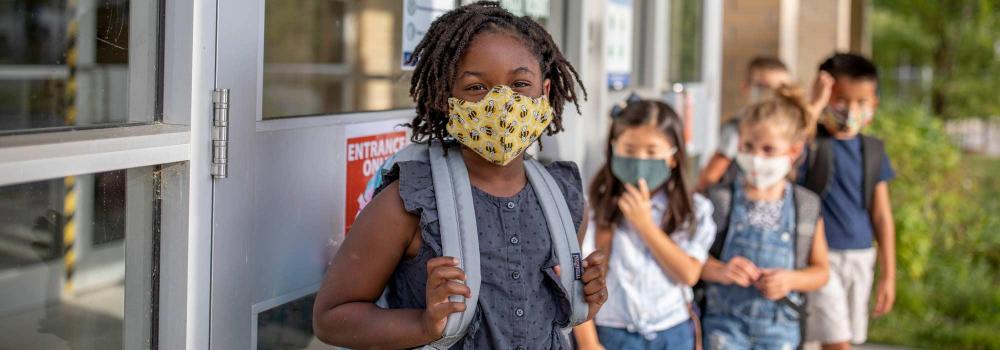As of writing, the Centers for Disease Control and Prevention estimate that over three-quarters of the population have received at least one dose of the vaccine, and over 60% have received at least two doses. However, new coronavirus variants like omicron have been found to cause breakthrough cases, which has led to steady increases in case numbers worldwide. The U.S. has consistently had the second-highest amount of omicron patients worldwide with over 200,000 cases. Though doctors and scientists believe we’ve already seen the peak of omicron, individual towns may still see steep inclines in cases, and the threat of new variants never seems to quite leave the horizon.
In addition to being somewhat vaccine-resistant, the omicron variant has also been reported to affect children more than previous variants. Staff at the Cincinnati Children’s Hospital Medical Center have seen an eight-fold rise in hospitalizations among children during the omicron variant spike. As the original COVID-19 virus largely infected adults, this new revelation could spell trouble for schools. On top of the immediate risk, the CDC has also released a new study that found increased risk of diabetes in kids after they have recovered from the coronavirus.
The good news is that now more than ever, we have the resources to strengthen our fight against the virus. Years of study have given us new perspective on the environmental factors that have the highest impact on the spread or control of infection, like temperature and humidity. For this reason, and to help protect your staff and students against imminent dangers, it’s a good time to consider reinforcing your COVID-19 safety strategy.
Automated Monitoring for Environmental Surveillance
It’s important to note that the prevalence of the COVID-19 virus and its variants does not mean the elimination of cold and flu season; rather, schools and parents now have to worry about the effect of both on their children’s health and ability to be in school receiving the education attention they need. Therefore, it’s especially crucial that schools know as much about their environment as possible so that they can combat infection and prevent losses of in-person learning time.
The National Association of School Nurses have stood behind layered COVID-19 prevention strategies, like vaccines for eligible people, consistent masking in classrooms, and also increased indoor ventilation. Indoor air quality is a top concern for in-person learning environments. Primex OneVue Sense™ can help provide school staff with data about their IAQ with automated air quality monitoring. Temperature and Humidity Sensors automatically monitor room, showing measurements locally on the sensors’ screens and wirelessly reporting data to the OneVue® web-based software, which can be viewable by any user with access to a web browser.
If measurements rise above or fall below a customized range, the appropriate staff will be alerted via text message, phone call, or email so that they are able to take corrective action to fix aberrations. These alerts can be delivered discreetly to necessary staff, preventing the rise of concern among students.
How Temperature and Humidity Impact Coronavirus Spread
The effects of temperature and humidity on the spread of the coronavirus have been well-discussed over recent months. For example:
- Temperature: Several studies have found that, though the effects may be marginal, colder temperatures are related to an increase in spread of infection. An April 2021 study in the Journal of Medical Virology concluded that room temperature air can cool upper respiratory systems to below regular body temperatures, which could promote “rapid viral growth.” This risk of potential increase in viral growth may contribute to higher levels of transmission or even worse disease symptoms. Even more influential is the effect of humidity.
- Humidity: Higher levels of humidity have been shown to slow the spread of the coronavirus and other airborne illnesses, according to several collegiate professors. They found that the coronavirus decays more quickly when relative humidity is between 40-60% than lower percentages, and that drier air conditions increased travel of airborne pathogens like COVID-19 particles. IAQ sensor alerts from the Primex automated monitoring solution can let staff know when rooms are too dry, which allows for improvements to ventilation and air flow with humidifiers or windows.
Student Activity and the Spread of COVID-19
Even though environmental factors play a large role in the spread of illness, human behavior still has the biggest impact. From wearing masks to adhering to social distancing standards, individual actions can make a noticeable difference in transmission rates. That is why the ability to influence these individual choices could help school leaders remind students to practice effective coronavirus prevention methods.
OneVue Notify® InfoBoard™ displays, when connected to the OneVue web-based platform, can relay customizable visual-textual messages that could remind students to:
- Practice social distancing
- Wash hands regularly
- Wear masks when not eating or drinking
The combination of the OneVue Sense automated ambient air quality monitoring and the OneVue Notify InfoBoard displays can fortify COVID-19 prevention strategies by adding extra layers to your school’s safety plan. As you continue to navigate through the coronavirus variants, omicron and onward, and the additional dangers they present, let Primex help your school safely remain open.
